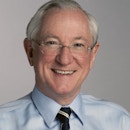How and Why Is Mercury Different From Its Sibling Rocky Planets?
- Speaker
-
 Sean C. Solomon, Ph.D. Director, Lamont-Doherty Earth Observatory; Associate Director for Earth Systems Science, The Earth Institute; William B. Ransford Professor of Earth and Planetary Science, Columbia University
Sean C. Solomon, Ph.D. Director, Lamont-Doherty Earth Observatory; Associate Director for Earth Systems Science, The Earth Institute; William B. Ransford Professor of Earth and Planetary Science, Columbia University
Presidential Lectures are free public colloquia centered on four main themes: Biology, Physics, Mathematics and Computer Science, and Neuroscience and Autism Science. These curated, high-level scientific talks feature leading scientists and mathematicians and are intended to foster discourse and drive discovery among the broader NYC-area research community. We invite those interested in the topic to join us for this weekly lecture series.
By clicking to watch this video, you agree to our privacy policy.
The MErcury Surface, Space ENvironment, GEochemistry, and Ranging (MESSENGER) spacecraft was the first to orbit the solar system’s innermost planet. Measurements acquired from orbit over four years, 2011-2015, provided the first global view of Mercury and changed our views on the formation and evolution of rocky planets.
In this lecture, Sean Solomon will summarize the scientific findings and the technical challenges from the MESSENGER mission. Mercury has a distinctive, chemically reduced composition marked by a high fraction of iron metal and abundances of volatile elements much higher than predicted by pre-mission planet formation theories. The planet hosts a dominantly dipolar internal magnetic field, but the dipole is substantially offset from the planet’s center. Mercury’s polar deposits, first detected with Earth-based radar, are confirmed to consist largely of water ice trapped in permanently shadowed regions inside polar impact craters. The water ice is mostly covered with a low-reflectance volatile material that is stable to temperatures somewhat higher than water ice and likely consists of organic material.
